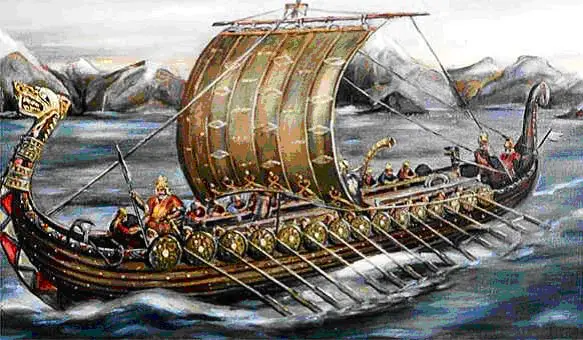The Danish Invasions of England
The ravaging of Lindisfarne was just the beginning. That 793 raid on a monastery was the first of many such raids by Danish raiders on English possessions. The raiders had come in search of food and wealth. Their homelands had been trading with England and with other nearby countries for some time, and they would have been acquainted of some of the riches, in money and land, that would have been ripe for the taking in the lands then run by the Angles, Saxons, and Jutes. The kingdoms of the Heptarchy had proven adept at conquering one another, but they were not well prepared to defend against a seaborne invasion. The monasteries at Lindisfarne and at Jarrow and Iona, populated by nonviolent religious types, would have seemed like easy pickings for big strong men armed with axes and other heavy weapons. But Danish raiders landed elsewhere along the eastern and sometimes southern coasts of England, and the plundering grew.
In 871, England's main defender, King Æthelred of Wessex, died. His younger brother Alfred ascended to the throne. This king's heroism and success military and diplomatically were so momentous that he is referred to as Alfred the Great. It didn't right away, though. Northumbria's King Healfdene ceded his lands to the Norsemen in 876. Alfred gathered a large army and fought valiantly but suffered a disastrous defeat in 878 and had to melt into the marshes of Athelney. Alfred regrouped, found more men and support, and struck back, resulting in a smashing victory over the Norse leader Guthrum at the Battle of Edington. Guthrum sued for peace, and he and Alfred approved the Treaty of Wedmore, which created the Danelaw and no small amount of respite from the fighting and dying. Part 2: Back and forth and Back Again |
|
Social Studies for Kids
copyright 2002–2024
David White



 Somewhere along the way, as did the Germanic peoples before them, the Danes decided that they rather liked the land in England, so much so that they decided to pack their ships with more and more well equipped fighters and the means for staying for awhile. A large Danish force (referred to by some historians as the Great Heathen Army) arrived in large force in East Anglia in 865 and cut their way north. The very next year, they sent shockwaves through England by capturing York, one of the country's two major cities. The raids continued.
Somewhere along the way, as did the Germanic peoples before them, the Danes decided that they rather liked the land in England, so much so that they decided to pack their ships with more and more well equipped fighters and the means for staying for awhile. A large Danish force (referred to by some historians as the Great Heathen Army) arrived in large force in East Anglia in 865 and cut their way north. The very next year, they sent shockwaves through England by capturing York, one of the country's two major cities. The raids continued.
